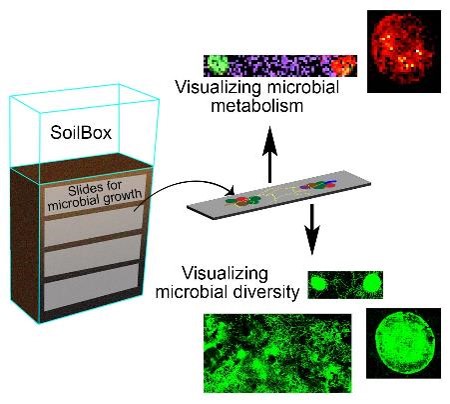Peeking Into the Lives of Soil Microbiomes
SoilBox provides in-depth imaging and characterization of soil microbial communities in their native environments.

The Science
To better characterize the vast diversity of soil microbes and their interactions, DOE researchers developed a high-tech simulated soil core called SoilBox. This 16.7-centimeter-deep box allows researchers to visualize soil microbes’ complex interactions using different imaging methods and facilitating, for the first time, visualization of the soil microbiome’s organization and community metabolism. Furthermore, SoilBox provides a tool for researchers to observe how soil microbial communities respond to environmental changes and perturbations.
The Impact
The complexity of soil makes spatial imaging of soil microbial communities challenging. Using SoilBox, researchers can now visualize the diversity and metabolic

landscape of the soil microbiome under different environmental conditions, such as soil moisture and temperature. Understanding the basic biology of the soil microbiome is necessary for understanding how native soil systems respond to environmental perturbations such as drought, lack of nutrients, and fire.
Summary
Soil-dwelling microbes are key players in the overall health of soil ecosystems, performing critical functions like carbon and nutrient cycling. The interplay between the soil microbiome and the soil it inhabits is a dynamic relationship heavily influenced by factors such as soil acidity, organic content, and temperature. The size and distribution of soil particles also affects many soil characteristics, adding to the already complex challenge of accurately describing structure-function relationships of soil microbial communities.
To address the difficulties of studying the soil microbiome in its native state and at a microscale resolution, a team of researchers from Pacific Northwest National Laboratory, led by Arunima Bhattacharjee and Chris Anderton, developed SoilBox. This system represents a soil ecosystem by simulating an ~12-cm-deep soil core; several windows facilitate molecular and optical imaging measurements that are crucial to understanding the nuanced interactions between the soil microbiome and its environment. This novel imaging capability allows scientists to study the dynamic landscape of soil microbial communities as they relate to environmental changes, including nutrient cycling.
This work overcomes the challenge of visualizing the diversity of soil microbial communities in the complex and ever-changing environment of soil. SoilBox will be used in the near future to investigate soil microbial community dynamics.
Contact
Chris Anderton, Pacific Northwest National Laboratory, christopher.anderton@pnnl.gov
Funding
This research was supported by the Department of Energy (DOE) Office of Biological and Environmental Research (BER) and is a contribution of the Scientific Focus Area "Phenotypic response of the soil microbiome to environmental perturbations." Pacific Northwest National Laboratory (PNNL) is operated for the DOE by Battelle Memorial Institute under Contract DE-AC05-76RLO1830. A portion of the research was performed using EMSL, the Environmental Molecular Sciences Laboratory, a DOE Office of Science User Facility sponsored by BER and located at PNNL.
Revised: February 25, 2020 | Published: February 28, 2020
A. Bhattacharjee et al.,“Visualizing microbial community dynamics via a controllable soil environment.” mSystems 5, 1:e00645-19 (2020). https://doi.org/10.1128/mSystems.00645-19.